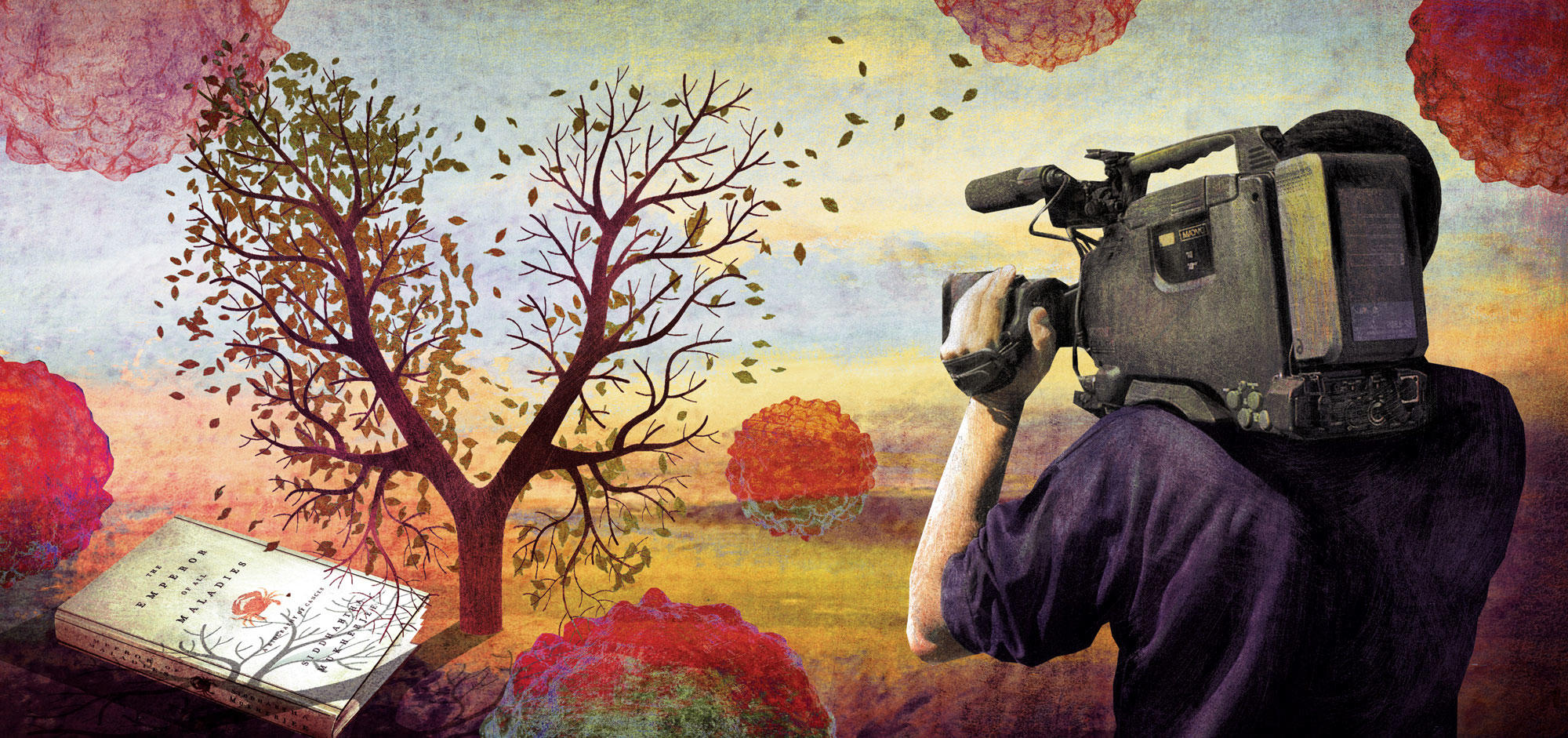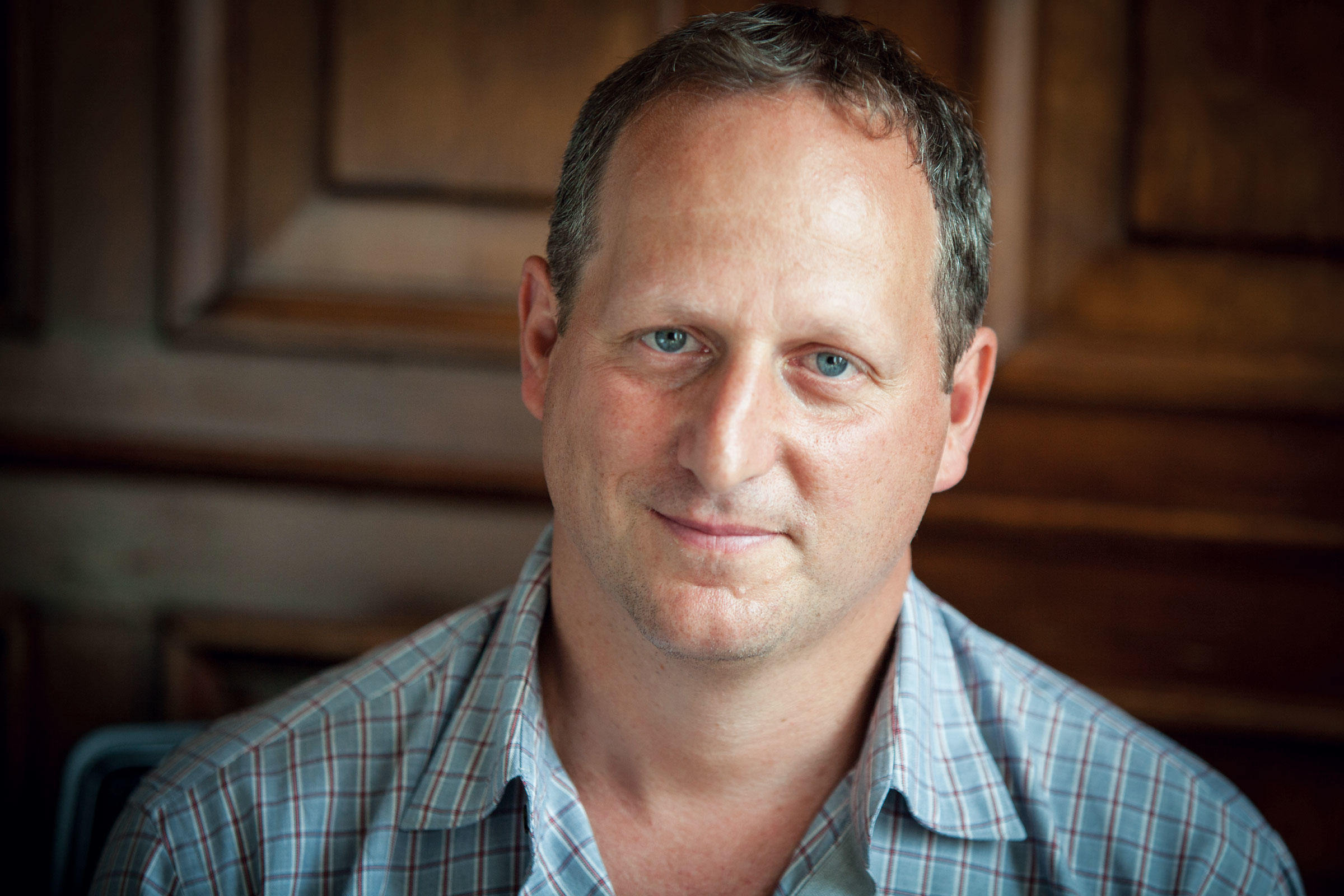On his first day in the recording studio, the narrator collapsed. The director, Barak Goodman ’86JRN, rushed into the booth and helped the man to his feet. Was he OK? Goodman noticed that his face was swollen. After a moment, the narrator, Edward Herrmann, in the warm, intelligent voice that Goodman loved, explained his situation. Now Goodman had a decision to make.
Goodman was used to the challenges that come with monumental projects. In his documentary work for PBS, he had tackled far-reaching topics like the My Lai massacre, the women’s movement, and the colorful political life of William Jefferson Clinton. But his latest film, a six-hour adaptation of The Emperor of All Maladies, the Pulitzer Prize-winning book by Columbia assistant professor of medicine Siddhartha Mukherjee, was Goodman’s most intricate assignment yet.
The documentary, which aired in March and April, would take on the history and science of cancer, and was slated to be one of PBS’s biggest broadcast events of 2015. Goodman could not risk any setbacks.
Herrmann, a venerable actor best known for his portrayals of FDR and his role as Richard Gilmore on TV’s Gilmore Girls, spoke with a self-possession that left a mark on Goodman. He revealed that he had stage-four glioblastoma — a brain tumor. (The facial swelling was from steroid treatments.) But Herrmann was resolved to narrate The Emperor of All Maladies. He assured Goodman that he could do it.
Goodman was reluctant. “I didn’t know if we would finish, and we were on a tremendous deadline at that point,” he says, seated in his dark-wood-paneled Brooklyn office. “But I rolled the dice, because I love the guy so much.”
Goodman, fifty-one, has wide, frost-blue eyes and the keen, engaged manner of a perpetual student. His films are immersive journeys into American history, eloquent and absorbing, and what he loves most about his job is the chance to dive into a topic and learn. The son of academics, he grew up in Berkeley and Philadelphia, studied US history at Harvard, and then went straight to Columbia’s Graduate School of Journalism, where he was the youngest member of his class.
“That was the year I woke up,” Goodman recalls. “I immediately thought: ‘This is it.’ I had great teachers who completely turned me on to journalism.” Among them was Anthony Lewis of the New York Times, who co-taught a class in constitutional law and journalism. “I wanted to be Tony Lewis,” Goodman says.
He took a step in that general direction by getting a part-time job at a Long Island newspaper, where, to his impatience, he had to cover things like local town-planning sessions. Meanwhile, some of his Harvard classmates were already at the Wall Street Journal and the New York Times.
One day, shortly after graduating, Goodman was visiting J-school interim dean Frederick Yu in his office when Yu’s phone rang. It was a TV station in Philadelphia. The station was looking for a young associate producer for a documentary series. Yu looked at Goodman and said, “You’re from Philadelphia, aren’t you?”
Goodman had never considered television. But he knew the station, knew the city, and decided to apply. He got the job and went back to his hometown.
The situation was not as advertised. The producer was hardly there, and the bulk of the responsibility fell to Goodman. “It was the craziest year,” Goodman says. “I had to come up with the stories and shoot them. I learned on the go. And I came to love all the tools in the toolbox. Music, visuals, writing: you could do all these things and put them together, and there it was. I was really converted to documentaries.”
Goodman returned to New York and got a job adapting the books of former Times Washington bureau chief Hedrick Smith for TV. (His exposure to Capitol Hill would serve him years later on his 2012 PBS film Clinton.) “It was a great education,” Goodman says, “but somewhere in the middle of it I decided I wanted to do my own thing.”
His catalyst was a 1985 documentary about Louisiana politician Huey P. Long, made by the filmmaker Ken Burns (with an assist from his brother Rice Burns ’78CC, ’83GSAS). Goodman saw Huey Long in 1989 and thought it was brilliant. Inspired to attempt something similar, he searched for a colorful character who hadn’t been covered in film and hit upon Richard J. Daley, the former mayor and Democratic Party machine boss of Chicago. Daley was just the sort of complicated, morally ambiguous figure that appealed to Goodman. After recruiting Burns’s cinematographer, Buddy Squires, and his writer, Geoff Ward, Goodman made his pitch to the National Endowment for the Humanities and got the funding. The film, titled Daley: The Last Boss, aired on the PBS series American Experience in 1996. Says Goodman: “Everything started with that film.”
Goodman embraced historical filmmaking. “You could make something moving and beautiful in a way you couldn’t with news,” he says. In 1996, he and his wife, Rachel Dretzin, a producer and director for PBS’s Frontline, formed a production company called Ark Media. Two of their PBS documentaries — the Emmy-winning Scottsboro: An American Tragedy, about the rape trials of nine young, innocent black men in 1930s Alabama, and the Peabody winning The Lost Children of Rockdale County, about teens in an Atlanta suburb who fall into a subculture of sex — sealed Ark’s stature. When Henry Louis Gates Jr. asked Ark to produce his series Finding Your Roots (2012-), the outfit went from a small boutique production house to a company of fifty people.
In 2013, Goodman got a call from WETA in Washington, DC. The station was developing a major PBS program — a Ken Burns project based on The Emperor of All Maladies. Burns, known for his multi-part sagas like Jazz, Baseball, and The Civil War, had lost his mother to cancer when he was eleven, so the project had particular meaning for him. He would executive-produce the film and bring in a director he liked.
After a long search, the Burns team had zeroed in on Goodman. Would he be interested in the job?
Goodman, who lost a grandmother to cancer, was intrigued. For one thing, the cancer-research fundraising organization Stand Up to Cancer was involved, and the group’s connections to the entertainment industry meant significant public attention for the project. Then Goodman read Mukherjee’s self-proclaimed “biography of cancer” and was floored by both the quality of the prose (“one of the best-written nonfiction books I’ve ever read”) and the sprawling ambition of the historical narrative. “Sid has this elegant way of translating science into metaphor that is so convincing and clear,” Goodman says. “It’s very impressive.” Goodman took the gig.
The demands facing the filmmaker were considerable. The Maladies team wanted to incorporate stories of current patients and update the ever-evolving science (the book was published in 2010). They embedded film crews at hospitals and looked for the doctors who would make the best characters. Through those doctors, they found the patients. They juggled multiple stories whose arcs they could not predict. (One outcome, involving a child, shocked everybody, including the doctors.)
The difficulties inherent in such a weighty undertaking extended, naturally, to the filmmaking itself. “Weaving history, contemporary stories, and a lot of science all into one film was very tough,” Goodman says. “I’ve never seen a project done this way.”
Throughout the process, Mukherjee worked closely with the filmmakers. “Sid certainly kept us honest sciencewise, but he also had lots of opinions about narrative structure and what emphasis to place on the different stories and characters,” Goodman says. “He saw cuts of the film and gave us notes. I’ve never involved an author of a book that closely in filmmaking. We didn’t always see perfectly eye to eye, and, as with Ken and me, we both sometimes had to compromise. But we definitely wanted his advice and listened very carefully to him — no one knows his story better than he does.”
Along the way, Goodman gained a new respect for scientists. “Ninety-nine percent of the time, they fail. It’s that one percent that makes all the difference. They have to have this unbelievable drive and commitment and resilience. Sure, they’re after fame and glory, but they’re also buried in their labs, trying to advance humanity’s knowledge.” And, Goodman adds, they’re getting results. “With cancer, we’re approaching a survival rate of two-thirds of diagnosed cases.”
Edward Herrmann, too, was driven and committed and resilient. But he was not a survivor.
“It was hard,” says Goodman, his feeling for Herrmann softening his voice. “There were days when he was slowed down by chemo. We had to struggle through the narration. The recording took twice as long as it normally would. He gave it everything he had and did a tremendous job.” Goodman pauses. “We said goodbye, and six weeks later he was dead.”
Anyone who has been touched by cancer knows something of the plunging terror, the wild anxiety, the knee-buckling blow of the irrefutable word. But Goodman, who has seen front-line science and terrible grace, desperate agony and humbling recovery, wants to demystify the disease and take some of that fear away. He sees the documentary not just as a historical survey of cancer treatment but also as a witness to its future promise.
“I hope people aren’t as terrified of cancer after seeing the film as they were going in,” Goodman says. “Cancer is punishing. It’s difficult. But more and more patients are getting through it.”




